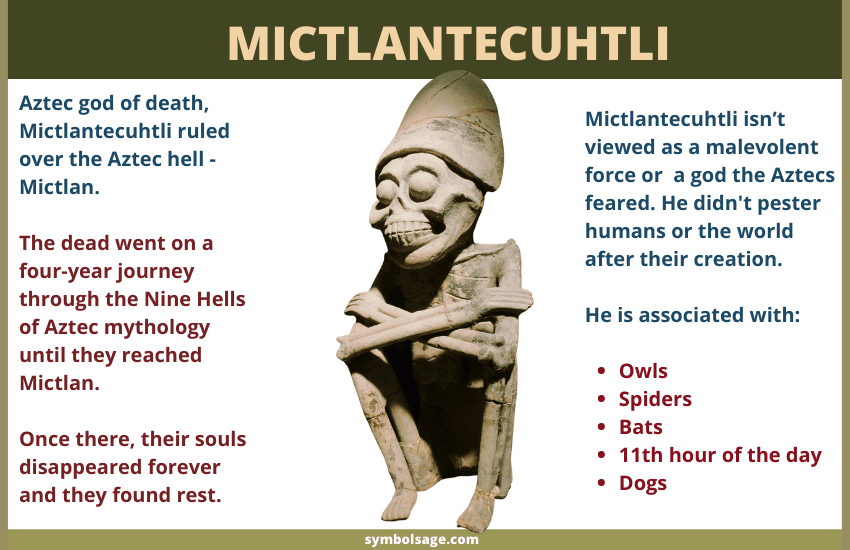News
Mictlantecuhtli: The Aztec God of the Underworld

Mictlantecuhtli is one of the most important gods in Aztec mythology. He is known as the god of death and the underworld. Mictlantecuhtli ruled over Mictlan, the Aztec underworld where the souls of the dead would journey after life. Despite his frightening appearance, he was not considered evil but a necessary part of life’s cycle.
Let’s dive into who Mictlantecuhtli is, his role in Aztec culture, and why he is still remembered today.
Who is Mictlantecuhtli?

Mictlantecuhtli (pronounced “Meek-tlan-teh-coot-lee”) was the Aztec god who ruled over Mictlan, the deepest level of the underworld. He was often depicted as a skeletal figure with a skull face, wearing a headdress made of owl feathers. Sometimes, he would also be shown with bones, blood, or a necklace made of human eyeballs, symbolizing his connection to death.
Mictlantecuhtli’s name means “Lord of Mictlan.” Mictlan was not a place of punishment but rather the final destination for most souls after death. The journey to Mictlan was long and challenging, taking four years for a soul to reach its end. During this journey, Mictlantecuhtli and his wife, Mictecacihuatl, would oversee the souls’ passage and ensure they reached their final resting place.
read also : newsmegazine.co.uk/
The Role of Mictlantecuhtli in Aztec Culture
Mictlantecuhtli was a significant figure in Aztec culture for several reasons:
- God of Death and the Underworld: As the god of death, Mictlantecuhtli represented the end of life. The Aztecs believed that death was not something to be feared but a natural part of life. Mictlantecuhtli played an important role in guiding the dead to their next journey.
- Keeper of Souls: Mictlantecuhtli was responsible for receiving the souls of the dead. Unlike other cultures where the underworld was a place of punishment, Mictlan was simply where most people went after they died. His role was to keep the balance between life and death.
- Balance of Life: In Aztec beliefs, life and death were interconnected. Mictlantecuhtli was a symbol of this balance. While other gods represented creation and life, Mictlantecuhtli represented the end that made room for new life to begin.
Stories of Mictlantecuhtli
Mictlantecuhtli appears in several Aztec myths. One of the most well-known stories involves him and Quetzalcoatl, the god of wind and wisdom.
In this story, Quetzalcoatl went to Mictlan to retrieve the bones of the dead so he could create humans in the new world. Mictlantecuhtli agreed to give him the bones but set a trap, hoping Quetzalcoatl would fail. However, Quetzalcoatl outsmarted Mictlantecuhtli and escaped with the bones. This myth symbolizes the cycle of life and death and shows that even the god of death can be challenged.
Worship and Rituals
The Aztecs held many rituals and ceremonies to honor Mictlantecuhtli. These rituals often took place in temples dedicated to him, which were decorated with skulls and bones to symbolize his power over death. Offerings to Mictlantecuhtli included incense, animals, and sometimes even human sacrifices, which were believed to keep the balance between life and death.
During these ceremonies, priests would wear masks and costumes that resembled Mictlantecuhtli. These rituals were meant to show respect to the god and ask for his favor in guiding the dead to their peaceful rest.
How Mictlantecuhtli is Remembered Today
Today, Mictlantecuhtli is remembered as an essential part of Aztec culture and religion. He is often depicted in art, literature, and even in popular culture. His image appears in modern representations of Dia de los Muertos, or the Day of the Dead, a Mexican holiday that honors the deceased. While this holiday has roots in ancient indigenous beliefs, including Aztec traditions, it has evolved over time to become a celebration of life and death.
Mictlantecuhtli’s story also continues to interest historians, scholars, and people fascinated by ancient cultures. His role in myths and the stories surrounding him help us understand how the Aztecs viewed the world and the cycle of life and death.
Conclusion
Mictlantecuhtli, the Aztec god of the underworld, played a crucial role in the ancient world. As the ruler of Mictlan, he was responsible for guiding the dead and keeping the balance between life and death. Even though he is associated with death, Mictlantecuhtli was not feared but respected as a necessary part of existence.
Today, he remains a powerful symbol of the Aztec culture’s unique understanding of life, death, and the afterlife. His presence in myths, rituals, and even modern celebrations reminds us of the importance of embracing every part of life’s journey.
visit for more : newsmegazine.co.uk/
Business
Immediate A7 Maxair: Your Comprehensive Guide
Business
Email Marketing Jobs Remote: Your Guide to a Growing Field

In today’s digital world, email marketing plays a crucial role in how businesses communicate with their customers. As companies increasingly rely on email to reach their audiences, the demand for skilled professionals in this area continues to grow. If you’re considering a career in email marketing, especially in a remote setting, this article is for you! We’ll explore what email marketing jobs entail, the skills you need, the benefits of working remotely, and how to find the right opportunities.
What is Email Marketing?

read also: essay-on-chandrayaan-3/
Before diving into jobs, let’s clarify what email marketing is. Email marketing involves sending targeted messages to a group of people via email. These messages can range from newsletters and promotional offers to personalized communications. The main goal is to engage customers, encourage sales, and build lasting relationships with them.
The Rise of Email Marketing Jobs
The shift towards digital marketing has created a surge in email marketing roles. Businesses recognize the importance of connecting with customers through email. With platforms like Mailchimp, Constant Contact, and Sendinblue making it easier to create and manage campaigns, there’s a growing need for professionals who can design, execute, and analyze these campaigns.
Types of Email Marketing Jobs
Email marketing jobs come in various forms, each focusing on different aspects of the marketing process. Here are some common roles you might encounter:
- Email Marketing Specialist: This role involves creating and managing email campaigns, segmenting lists, and analyzing performance metrics to improve future campaigns.
- Email Marketing Manager: A step up from the specialist, this position typically oversees the entire email marketing strategy, including team management and budget allocation.
- Content Writer: Writers focus on crafting engaging email content that resonates with the target audience, encouraging them to take action.
- Graphic Designer: Designers create visually appealing email templates and graphics that enhance the overall message.
- Data Analyst: Analysts examine the performance of email campaigns, looking at metrics such as open rates, click-through rates, and conversions to make data-driven decisions.
Skills Required for Email Marketing Jobs
To succeed in email marketing, you need a mix of creative and analytical skills. Here are some essential skills for remote email marketing jobs:
- Copywriting: Strong writing skills are crucial for crafting compelling email content that grabs attention and encourages action.
- Design Skills: While not mandatory, having a good eye for design can help you create visually appealing emails or work effectively with designers.
- Analytical Skills: You should be comfortable analyzing data and metrics to assess the performance of your campaigns and make informed decisions.
- Technical Proficiency: Familiarity with email marketing platforms and tools, as well as basic HTML/CSS knowledge, can be beneficial.
- Communication Skills: Since remote work often relies on digital communication, strong verbal and written communication skills are vital.
Benefits of Remote Email Marketing Jobs
Working remotely in email marketing offers numerous advantages:
- Flexibility: Remote jobs allow you to set your own schedule and work from anywhere, whether it’s your home or a coffee shop.
- Work-Life Balance: Without a daily commute, you can spend more time with family, pursue hobbies, or simply enjoy a better work-life balance.
- Access to Global Opportunities: Remote work opens doors to companies around the world, expanding your job prospects beyond your local area.
- Cost Savings: Working from home can save you money on transportation, work attire, and meals.
How to Find Remote Email Marketing Jobs
Finding remote email marketing jobs can seem daunting, but with the right approach, it can be straightforward. Here are some tips to help you get started:
- Job Boards: Websites like Indeed, Glassdoor, and LinkedIn often have dedicated sections for remote jobs. Use keywords like “remote email marketing” to narrow your search.
- Freelance Platforms: Consider platforms like Upwork, Freelancer, or Fiverr. These sites allow you to find freelance email marketing gigs, which can lead to long-term opportunities.
- Networking: Join professional groups on social media platforms, such as Facebook or LinkedIn. Networking can help you connect with others in the field and learn about job openings.
- Company Websites: Many companies post job openings directly on their websites. Identify companies you’re interested in and check their careers page regularly.
- Email Marketing Communities: Engage with communities focused on email marketing. Websites like Email Geek and Email Marketing Community provide resources and job boards.
click below: thejavasea-me-leaks-aio-tlp142/
Preparing for Your Remote Email Marketing Job
Once you find a position that interests you, it’s time to prepare. Here are some steps to ensure you’re ready for your remote email marketing job:
- Create a Strong Resume: Highlight your relevant skills and experiences. Tailor your resume to emphasize your expertise in email marketing and any specific tools you’ve used.
- Build a Portfolio: If possible, create a portfolio showcasing your best email campaigns, writing samples, and design work. This can set you apart from other candidates.
- Stay Updated on Trends: The digital marketing landscape is constantly evolving. Subscribe to industry blogs, attend webinars, and participate in online courses to keep your skills sharp.
- Practice Your Interview Skills: Prepare for common interview questions related to email marketing, such as your experience with segmentation or how you measure campaign success.
- Familiarize Yourself with Tools: Ensure you’re comfortable using popular email marketing tools and platforms. Familiarity with tools like Mailchimp, HubSpot, or ActiveCampaign can give you an edge.
Conclusion
Email marketing jobs are a fantastic opportunity for those looking to work remotely while playing a vital role in a company’s marketing strategy. With the right skills, preparation, and approach, you can find a rewarding career in this growing field. Whether you’re just starting or looking to advance your career, the world of email marketing is waiting for you.
FAQs
1. What skills do I need for an email marketing job?
Key skills include copywriting, design skills, analytical abilities, technical proficiency, and strong communication skills.
2. How can I find remote email marketing jobs?
Use job boards, freelance platforms, networking, and check company websites for openings.
3. Is prior experience necessary for email marketing jobs?
While experience can be beneficial, many entry-level positions are available, and internships or freelance work can help build your resume.
4. What tools are commonly used in email marketing?
Popular tools include Mailchimp, HubSpot, Constant Contact, and Sendinblue.
5. What are the benefits of working remotely in email marketing?
Benefits include flexibility, work-life balance, access to global job opportunities, and cost savings.other blogs
News
CSR Full Form: Understanding Corporate Social Responsibility
-

 Business1 month ago
Business1 month agoNippyFiles: The Complete Guide to Downloading and Sharing Files
-

 Celebrity6 months ago
Celebrity6 months agoSean Kaufman Ethnicity, Wiki, Age, Career And More
-

 Sports1 month ago
Sports1 month agoArcenturf Gagnant: Your Ultimate Guide to Smart Turf Betting
-

 Tech2 months ago
Tech2 months agoWhat is Proxiyum? A Complete Guide to Web Proxy Services
-

 Celebrity6 months ago
Celebrity6 months agoWho Is Jennifer Hermoso Partner? Bio, Wiki, Age, Career, Net Worth And More
-

 Sports1 month ago
Sports1 month agoCleveland Cavaliers vs Boston Celtics Match Player Stats
-

 Celebrity6 months ago
Celebrity6 months agoJack Champion Height, Biography, Wiki, Age, Career And More
-

 Life Style6 months ago
Life Style6 months agoHow to Select a New Body Personal Care Professional





